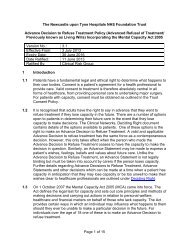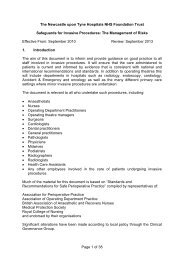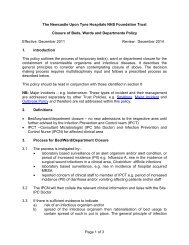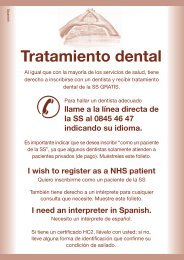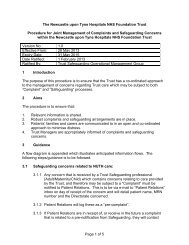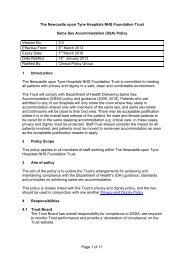Off site Policy (38KB pdf) - Newcastle Hospitals
Off site Policy (38KB pdf) - Newcastle Hospitals
Off site Policy (38KB pdf) - Newcastle Hospitals
You also want an ePaper? Increase the reach of your titles
YUMPU automatically turns print PDFs into web optimized ePapers that Google loves.
Data Transfer <strong>Policy</strong><br />
Confidential<br />
NEWCASTLE-UPON-TYNE HOSPITALS NHS TRUST.<br />
OFF SITE & DATA TRANSFER POLICY<br />
PROJECT NAME<br />
Data Transfer & Storage<br />
DOCUMENT TITLE<br />
<strong>Off</strong> Site & Data Transfer <strong>Policy</strong><br />
DOCUMENT VERSION Vers. 1.0<br />
RELEASE DATE November 2003<br />
DOCUMENT OWNER<br />
IM&T<br />
REVIEW DATE. November 2006<br />
<strong>Newcastle</strong>-upon-Tyne <strong>Hospitals</strong> NHS Trust<br />
Draft<br />
1 Nove
Data Transfer <strong>Policy</strong><br />
Confidential<br />
Contents<br />
DOCUMENT HISTORY………………………………………………………………………………..3<br />
DISTRIBUTION LIST…………………………………………………………………………………..3<br />
INTRODUCTION………………………………………………………………………………………..4<br />
MANAGEMENT………………………………………………………………………………………….4<br />
DATA PROTECTION ACT….……………………………………………………………….…………4<br />
TECHNICAL……………………………….……………………………………………………………..6<br />
SUMMARY….…………………………………..………………………………………………………...6<br />
ANNEX A Data Transfer Form………………………………………………………………………….7<br />
ANNEX B Extract from NHSIA Sysop 2002……………………………………………………………8<br />
<strong>Newcastle</strong>-upon-Tyne <strong>Hospitals</strong> NHS Trust<br />
Draft<br />
2 Nove
Data Transfer <strong>Policy</strong><br />
Confidential<br />
Version Release Date Amendment Summary<br />
Draft Ver 1.0 May. 2002 Draft version for discussion.<br />
Draft Ver 1.1 Jan 2003 Updated after BS7799 review.<br />
Name Role Department<br />
IM&T Group Document Owner Corporate<br />
Internal Audit Audit Audit<br />
Richard Oliver Author IT Security<br />
<strong>Newcastle</strong>-upon-Tyne <strong>Hospitals</strong> NHS Trust<br />
Draft<br />
3 Nove
Data Transfer <strong>Policy</strong><br />
Confidential<br />
INTRODUCTION<br />
This <strong>Policy</strong> is in line with the Trust Information <strong>Policy</strong> and IM&T Security <strong>Policy</strong> and provides<br />
guidelines for the management and use of Trust information and equipment outside the Trust.<br />
Equipment and data will not be taken off <strong>site</strong> without formal signed approval, other than<br />
to transport it from one of the Trust’s <strong>site</strong>s to another.<br />
Portable equipment is very vulnerable to theft, loss or unauthorised access. Strong<br />
security measures should be introduced as soon as practicable after purchase,<br />
particularly if such equipment has networked access capability.<br />
To preserve the integrity of data, frequent transfers should be made to the Trust network<br />
servers.<br />
Managers and Users should be aware that whilst this policy refers directly to personal data,<br />
corporate or business information may be sensitive when aggregated together and should be<br />
considered for protection in the same way as personal data.<br />
Managers and Users will comply with the following guidance on the practical implementation of<br />
the <strong>Policy</strong>.<br />
Personal portable devices.not owned by the Trust ie; Laptops and PDAs<br />
(Personal Digital Assistant) MUST NOT be connected either directly or<br />
indirectly to the Trust network. Without the knowledge and consent of the<br />
IT Department.<br />
MANAGEMENT<br />
1. Managers must maintain a list of ALL staff who send or take personal data off-<strong>site</strong>, which is<br />
normally kept on systems in the Trust.<br />
2. Users must be aware that they are responsible for the security of the data they are taking<br />
away, whether on a laptop PC, hand-held device or on removable media (e.g. floppy<br />
disk/CD/tape).<br />
3. A Data Transfer Form will be completed for all instances of data being taken or transmitted<br />
off-<strong>site</strong>. An example is attached at Annex A. If the transfer involves a non-NHS third party<br />
then a Third Party Agreement should also be completed.<br />
On Completion the form should be returned to the IT security team.<br />
4. Specific guidance will be prepared for staff wishing to work at home on systems not owned by<br />
the Trust, particularly with regard to access controls and virus protection software.<br />
<strong>Newcastle</strong>-upon-Tyne <strong>Hospitals</strong> NHS Trust<br />
Draft<br />
4 Nove
Data Transfer <strong>Policy</strong><br />
Confidential<br />
DATA PROTECTION ACT<br />
5. If data copied from Trust systems is to be used for a different Purpose 1 than registered, the<br />
Caldicott Guardian & Data Protection officer must be informed.<br />
6. If the person taking the data off-<strong>site</strong> is going to use it legitimately for his/her own purposes<br />
(e.g. a Consultant who has a Private Practice), then the individual MUST register separately<br />
with the Data Protection Commissioner, and comply with the Procedures and Principles of<br />
the Data Protection Act.<br />
TECHNICAL<br />
7. Laptop computers are able to hold as much sensitive personal data as desktop PCs. Users<br />
should assess the risks of taking data with them to meetings or to work on at home.<br />
Particular care should be taken during transportation to prevent systems being stolen from<br />
vehicles or by leaving items unattended, even momentarily.<br />
8. At the very least, users should password protect individual files as they are saved to disk,<br />
using their application. This should happen whether the files are saved to the internal hard<br />
disk of a portable PC or temporary storage such as a floppy disk or 'zip' drives.<br />
9. If the system is normally networked within the Trust, then strong authentication must be<br />
implemented if the system is to be used by dialling in to the Trust network from outside. See<br />
separate guidance on External Access to Trust Networks. At present, authentication is<br />
effected with the use of SecureIT , a 'smart card' which provides a frequently changing<br />
numeric password that is synchronised to the system within the Trust. This card must not be<br />
kept with the system.<br />
10. The standard method of marking portable systems as Trust property (Trust asset tag) must<br />
be rigorously enforced, as this may be the only way of proving ownership of the hardware if<br />
the data is password protected or encrypted and therefore not readable.<br />
11. A back-up copy of the data must be maintained on systems within the Trust, and updated as<br />
soon as practicable whenever the data on the portable system is changed.<br />
12. PDA. The Trust does not supply PDAs as standard. The use of personally owned PDAs must<br />
be registered with the IT Department.<br />
13. Trust data held on PDAs is subject to the same conditions as all other methods of data<br />
transfer. A sensitive data transfer form must be completed and the PDA owner must register<br />
the use of data with the Caldicott Guardian<br />
1 It may be that the Purposes of Use registered by the Trust were, for example, Health<br />
Administration and Services. If the data were being taken off-<strong>site</strong> for the purpose of Research,<br />
then the Data User (the Clinician responsible for the collection and use of the data) would need to<br />
change the internal registration and begin to inform all new Data Subjects of the new Purpose<br />
before he could authorise its removal and use. If data already collected is involved, then ‘Positive<br />
Consent’ may be required from individual Data Subjects, particularly if identifiable Personal Data<br />
is being used.<br />
<strong>Newcastle</strong>-upon-Tyne <strong>Hospitals</strong> NHS Trust<br />
Draft<br />
5 Nove
Data Transfer <strong>Policy</strong><br />
Confidential<br />
14. Technical advice and guidance should be sought in the first instance from the IT Helpdesk on<br />
25954. Problems relating to personnel and procedures should be raised with the IT Security<br />
<strong>Off</strong>icer or Data Protection <strong>Off</strong>icer.<br />
SUMMARY<br />
The use of portable/laptop/hand-held computers is becoming increasingly popular, and the l l<br />
likelihood of systems being stolen or magnetic media being lost becomes greater. Issues<br />
regarding the risk of access by unauthorised persons or propagation of software viruses must<br />
also be addressed.<br />
Management and users must ensure that they minimise these risks and provide adequate<br />
technical and procedural protection against loss or disclosure.<br />
Annex A<br />
Sensitive Data Transfer Form<br />
<strong>Newcastle</strong>-upon-Tyne <strong>Hospitals</strong> NHS Trust<br />
Draft<br />
6 Nove
Data Transfer <strong>Policy</strong><br />
Confidential<br />
SENSITIVE DATA TRANSFER FORM<br />
NAME<br />
ADDRESS<br />
DATA TRANSFERRED FROM:<br />
DATA TRANSFERRED TO:<br />
(if non-NHS 3 rd party, agreement attached)<br />
PURPOSE/REASON for<br />
TRANSFER<br />
DATA TYPE<br />
e.g. patient, staff,<br />
business/finance<br />
DATA DESCRIPTION<br />
DATABASE(S) USED<br />
e.g. PAS, Pathology, Radiology<br />
PHYSICAL TRANSFER METHOD<br />
e.g. Floppy, Tape, Network,<br />
NHSNet, Portable PC<br />
SOFTWARE FORMAT USED<br />
e.g. Word, Excel, CSV, etc.<br />
ENCRYPTED or UNENCRYPTED<br />
DATE and TIME OF TRANSFER<br />
or commencement if ongoing<br />
FREQUENCY IF ONGOING<br />
I the undersigned certify that the personal data being received will not be disclosed to<br />
unauthorised persons. The Data and their Purposes of Use are registered under the Data<br />
Protection Act 1998 and my organisation/company is committed to compliance with the Data<br />
Protection Principles.<br />
DATE<br />
SIGNATURE<br />
<strong>Newcastle</strong>-upon-Tyne <strong>Hospitals</strong> NHS Trust<br />
Draft<br />
7 Nove
Data Transfer <strong>Policy</strong><br />
Confidential<br />
JOB TITLE<br />
Annex B.<br />
Extract from NHSIA Sysops 2002 published 26 th Sept.<br />
2. General Risk Management Principles<br />
2.1 Using a PDA involves Risk Management. (BS7799-2:2002 Clause 4.2.1) If NHS User<br />
Organisations were to adopt a Risk Avoidance strategy then PDAs could not be used at all.<br />
Organisations and Users have to accept that there are some risks and occasionally breaches,<br />
compromises and incidents will happen. Should the rate of occurrence of such breaches<br />
compromises and incidents rise to an unacceptable level then local policies derived from this<br />
document, and this document itself, must be reviewed.<br />
2.2 Individual users or groups of users should not make unilateral decisions, based on this<br />
document, on using PDAs for NHS business purposes. They must follow the Security <strong>Policy</strong> and<br />
Operating Instructions issued by their organisations. (BS7799-2: 2002 Annex A 3.1) They<br />
must note that, as with fully connected IT systems, it is not acceptable to<br />
use PERSONAL IT equipment for the storage or processing of Patient<br />
Identifiable or other NHS sensitive data or for such equipment to be<br />
connected to any NHSnet connected system.<br />
2.3 PLEASE COMPLETE THIS FORM AND RETURN TO:<br />
IT SECURITY OFFICER<br />
IT DEPARTMENT<br />
ROYAL VICTORIA INFIRMARY<br />
QUEEN VICTORIA ROAD<br />
NEWCASTLE-UPON-TYNE<br />
NE1 4LP<br />
<strong>Newcastle</strong>-upon-Tyne <strong>Hospitals</strong> NHS Trust<br />
Draft<br />
8 Nove



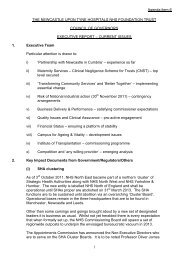
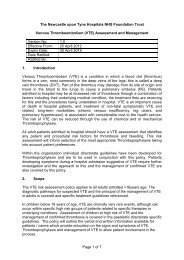
![Standard Precautions Policy - 112KB [PDF] - Newcastle Hospitals](https://img.yumpu.com/51150129/1/184x260/standard-precautions-policy-112kb-pdf-newcastle-hospitals.jpg?quality=85)
![Oxygen Management Policy - 38KB [PDF] - Newcastle Hospitals](https://img.yumpu.com/50798872/1/184x260/oxygen-management-policy-38kb-pdf-newcastle-hospitals.jpg?quality=85)
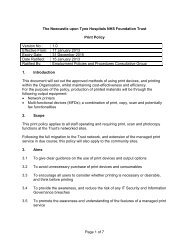
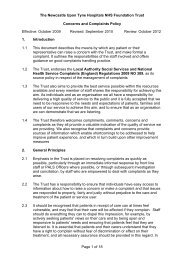
![Patient Identification Policy - 130KB [PDF] - Newcastle Hospitals](https://img.yumpu.com/49156101/1/190x245/patient-identification-policy-130kb-pdf-newcastle-hospitals.jpg?quality=85)
